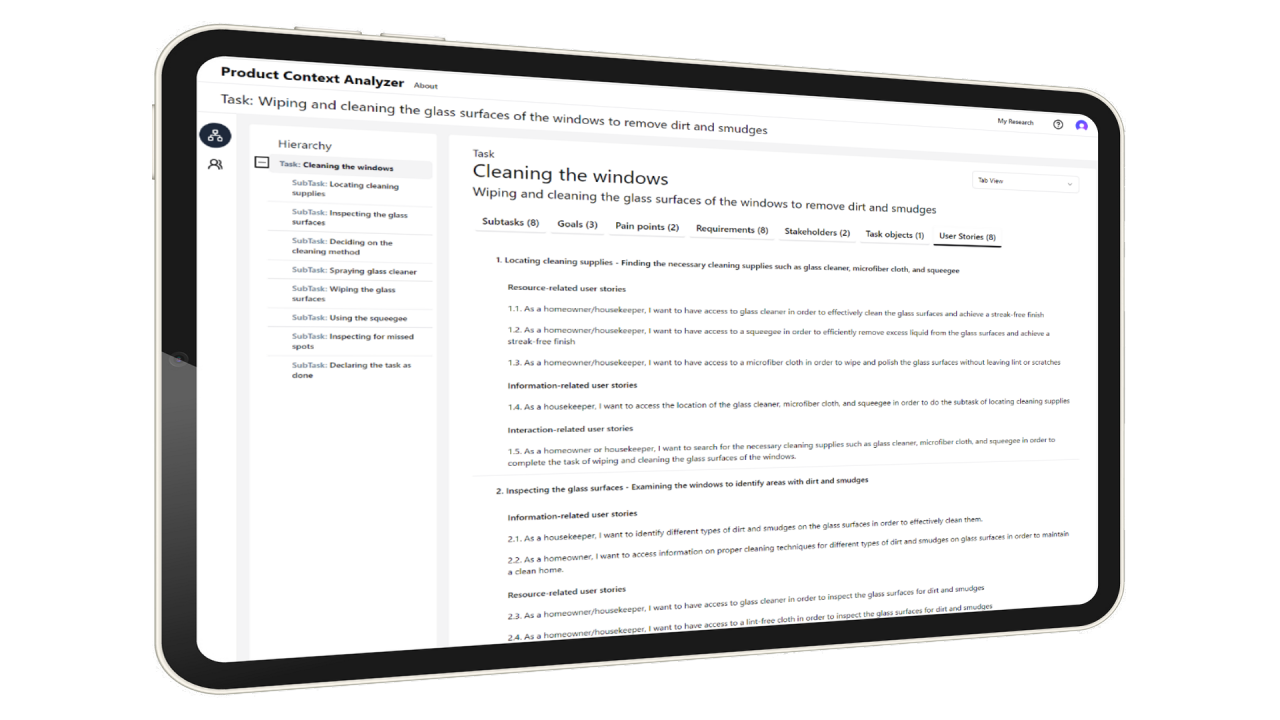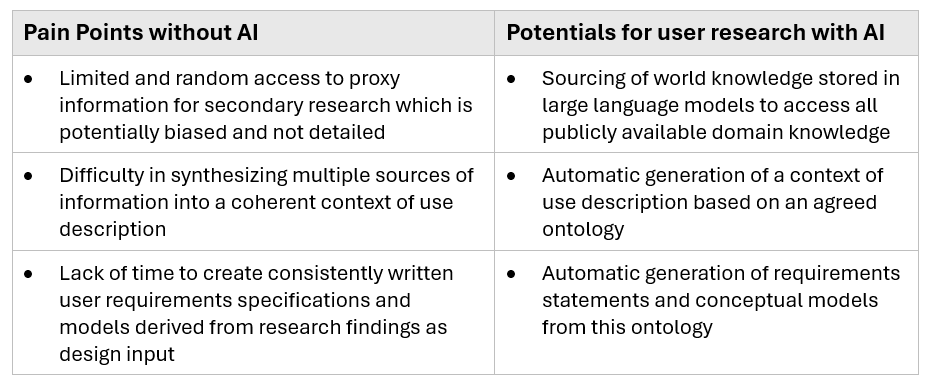
AI First User Research
Summary
For decades, UX professionals have emphasized that understanding the user is a critical step in getting the user experience of a product right. But while it is easy to agree on the need for upfront user research as part of a project, it is hard to get product teams to actually do it. This is largely due to the cost, specialized resources, and complex logistics of scheduling interviews with actual users. As a result, primary research is often replaced by interviewing internal subject matter experts or conducting design workshops to brainstorm basic knowledge about a product's intended end user.
With the emergence of generative AI tools, an alternative approach is to use ChatGPT-like tools to access this knowledge stored in these foundational LLM systems. However, in order to use such public LLM systems for product design, this information must be structured into a coherent description of a product's context of use, which transforms unstructured textual responses from these generative chat tools into structured information consisting of user tasks and subtasks ("task models"), user profiles together with their goals and pain points.
To streamline the gathering of context information and structuring of user requirements, we introduce a dedicated AI tool that automates the fact-gathering and standardizes the way user requirements are specified and documented. As a result, secondary research is performed at the speed of thought, saving product teams weeks of time in gaining a solid understanding of user requirements that can serve as an essential and comprehensive basis for design decisions.
Primary User Research versus Secondary User Research
Interviewing and/or observing users is a labor- and time-intensive project in itself. User profiles must be developed and screeners must be hired to recruit the right people to talk to. Interviewing and observing users requires skilled UX professionals. After the actual user research is done, the question arises, "What do we do with all this information?" For all these reasons, a decent user research project takes weeks, if not months, because scheduling user interviews is difficult and time-consuming, and the synthesis and documentation often becomes a chore rather than a core activity because the UX researcher does not have the quality time to focus on just one project.
Given these organizational challenges and limited ability to scale, the question arises, "Can we just ask Chat GPT to tell us everything about our users" and skip primary user research altogether?
Primary research assumes that data collected directly from the source in the context in which a product is used will be more authentic, detailed, and reveal additional hidden pain points. Secondary research assumes that existing data about the context of use can be inventoried, e.g. by searching studies and publications on the Internet, by interviewing subject matter experts, or by conducting workshops with the product team in which team members share their knowledge about the users and their context based on past work experience or based on past research projects involving real user data.
This type of secondary research is a logical and efficient first step in user research to gather information that does not require direct user interviews or observations. Good secondary research helps to identify what information is already available (known knowns) and allows the formulation of focused research questions that guide subsequent primary research to identify the "known unknowns" in direct contact with users. For example, in our consulting practice, we typically start our projects with a two-day "user requirements sprint" to allow stakeholders to share their existing domain knowledge.
What to do with all this information?
Whether secondary or primary research is conducted, the user researcher is typically tasked with documenting all findings and insights in the form of a user research report and other aggregated artifacts that can be shared with all team members.
Documenting, structuring, and synthesizing user research data can take a long time, whether it was collected through primary research, secondary research, or both. Many research projects end with the creation of high-level personas that summarize "who are we designing for?" Other documentation approaches include journey maps and user story maps. Regardless of the approach used to document user research data, the ultimate goal is to inform product design about strategic product directions and to ground design decisions in an explicit set of user requirements. User requirements are statements that specify what information a user should be able to obtain from a product, system, or service, and what choices and inputs must be enabled when performing real-world tasks.
Because this documentation is labor-intensive and must serve multiple stakeholders, there is a tendency to shortcut the discovery process and formulate and prioritize design ideas directly as the output of the research or design workshop. As a result, the product design has certain aspirational use cases to focus on, but lacks documentation of explicit requirements that are solution agnostic and may be valuable beyond the initial release. This problem arises when planning development sprints because there are no written use cases and user requirements available to inform, evaluate, and test the interaction design.

We believe that there is a huge untapped opportunity for generative AI technology to address these pain points in user research and radically improve the efficiency and quality of research results:
Introducing the AI-based User Research Service “Product Context Analyzer”
Many generative AI tools focus on facilitating primary research, such as generating interview questions or summarizing interview transcripts. Other generative tools focus on generating the UI itself, such as generating wireframes. But none of these tools solve the problem that user research is extremely labor-intensive, and that creating and updating consistent user requirement specifications is nearly impossible at the pace at which projects are run.
With the Product Context Analyzer®, we are introducing a new AI-first service that not only radically redefines how secondary research is being done, but which is automatically generating the documentation of the research. Instead of facilitating traditional user research activities, this service uses generative AI to automate the secondary research and the documentation of user requirements and user stories. The only input required from the user researcher to initiate the secondary research is a human-centered description of the use case your product should support, for example the description of a task performed by a specific user role under specific circumstances.
This initial input corresponds to the definition of usability, which is defined as a measure of how well a specific user in a specific context can use a product/design to achieve a specified goal effectively, efficiently, and satisfactorily.
Based on this minimal user input, the Product Context Analyzer® generates a detailed description of the context of use related to this use case with task flows, stakeholder profiles, goals and pain points, which can be interactively explored. Each context analysis generates requirements and insights that guide your product design throughout the product development life cycle.
This radically new generative AI service turns weeks of user research and documentation into seconds of entering a simple description of a human activity into the Product Context Analyzer®. This AI-first solution will make automated secondary research your primary approach to scaling user research in your organization and serving all product teams with detailed requirements.
About the Authors
Joerg Beringer and Thomas Geis have been working in user research, user requirements engineering, and conceptual design for the past 30 years. In 2024, Joerg and Thomas founded ProContext Inc., a Silicon Valley startup committed to delivering AI-first tools that help product teams gain a solid understanding of user requirements that serve as a comprehensive basis for informed design decisions.